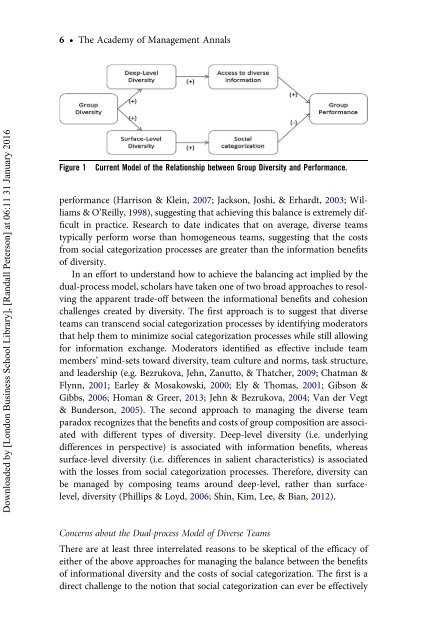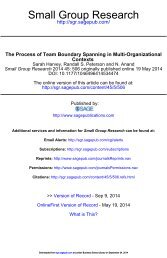A Dynamic Perspective on Diverse Teams: Moving From The Dual Process Model to A Dynamic Coordination-Based Model of Diverse Team Performance - Kannan Srikanth, Sarah Harvey & Randall Peterson
The existing literature on diverse teams suggests that diversity is both helpful to teams in making more information available and encouraging creativity and damaging to teams in reducing cohesion and information sharing. Thus the extant literature suggests that diversity within teams is a double-edged sword that leads to both positive and negative effects simultaneously.
The existing literature on diverse teams suggests that diversity is both helpful to teams in making more information available and encouraging creativity and
damaging to teams in reducing cohesion and information sharing. Thus the
extant literature suggests that diversity within teams is a double-edged sword
that leads to both positive and negative effects simultaneously.
Create successful ePaper yourself
Turn your PDF publications into a flip-book with our unique Google optimized e-Paper software.
6 † <strong>The</strong> Academy <strong>of</strong> Management Annals<br />
Downloaded by [L<strong>on</strong>d<strong>on</strong> Business School Library], [<strong>Randall</strong> Peters<strong>on</strong>] at 06:11 31 January 2016<br />
Figure 1<br />
Current <strong>Model</strong> <strong>of</strong> the Relati<strong>on</strong>ship between Group Diversity and <strong>Performance</strong>.<br />
performance (Harris<strong>on</strong> & Klein, 2007; Jacks<strong>on</strong>, Joshi, & Erhardt, 2003; Williams<br />
& O’Reilly, 1998), suggesting that achieving this balance is extremely difficult<br />
in practice. Research <strong>to</strong> date indicates that <strong>on</strong> average, diverse teams<br />
typically perform worse than homogeneous teams, suggesting that the costs<br />
from social categorizati<strong>on</strong> processes are greater than the informati<strong>on</strong> benefits<br />
<strong>of</strong> diversity.<br />
In an effort <strong>to</strong> understand how <strong>to</strong> achieve the balancing act implied by the<br />
dual-process model, scholars have taken <strong>on</strong>e <strong>of</strong> two broad approaches <strong>to</strong> resolving<br />
the apparent trade-<strong>of</strong>f between the informati<strong>on</strong>al benefits and cohesi<strong>on</strong><br />
challenges created by diversity. <strong>The</strong> first approach is <strong>to</strong> suggest that diverse<br />
teams can transcend social categorizati<strong>on</strong> processes by identifying modera<strong>to</strong>rs<br />
that help them <strong>to</strong> minimize social categorizati<strong>on</strong> processes while still allowing<br />
for informati<strong>on</strong> exchange. Modera<strong>to</strong>rs identified as effective include team<br />
members’ mind-sets <strong>to</strong>ward diversity, team culture and norms, task structure,<br />
and leadership (e.g. Bezrukova, Jehn, Zanut<strong>to</strong>, & Thatcher, 2009; Chatman &<br />
Flynn, 2001; Earley & Mosakowski, 2000; Ely & Thomas, 2001; Gibs<strong>on</strong> &<br />
Gibbs, 2006; Homan & Greer, 2013; Jehn & Bezrukova, 2004; Van der Vegt<br />
& Bunders<strong>on</strong>, 2005). <strong>The</strong> sec<strong>on</strong>d approach <strong>to</strong> managing the diverse team<br />
paradox recognizes that the benefits and costs <strong>of</strong> group compositi<strong>on</strong> are associated<br />
with different types <strong>of</strong> diversity. Deep-level diversity (i.e. underlying<br />
differences in perspective) is associated with informati<strong>on</strong> benefits, whereas<br />
surface-level diversity (i.e. differences in salient characteristics) is associated<br />
with the losses from social categorizati<strong>on</strong> processes. <strong>The</strong>refore, diversity can<br />
be managed by composing teams around deep-level, rather than surfacelevel,<br />
diversity (Phillips & Loyd, 2006; Shin, Kim, Lee, & Bian, 2012).<br />
C<strong>on</strong>cerns about the <strong>Dual</strong>-process <strong>Model</strong> <strong>of</strong> <strong>Diverse</strong> <strong><strong>Team</strong>s</strong><br />
<strong>The</strong>re are at least three interrelated reas<strong>on</strong>s <strong>to</strong> be skeptical <strong>of</strong> the efficacy <strong>of</strong><br />
either <strong>of</strong> the above approaches for managing the balance between the benefits<br />
<strong>of</strong> informati<strong>on</strong>al diversity and the costs <strong>of</strong> social categorizati<strong>on</strong>. <strong>The</strong> first is a<br />
direct challenge <strong>to</strong> the noti<strong>on</strong> that social categorizati<strong>on</strong> can ever be effectively
















